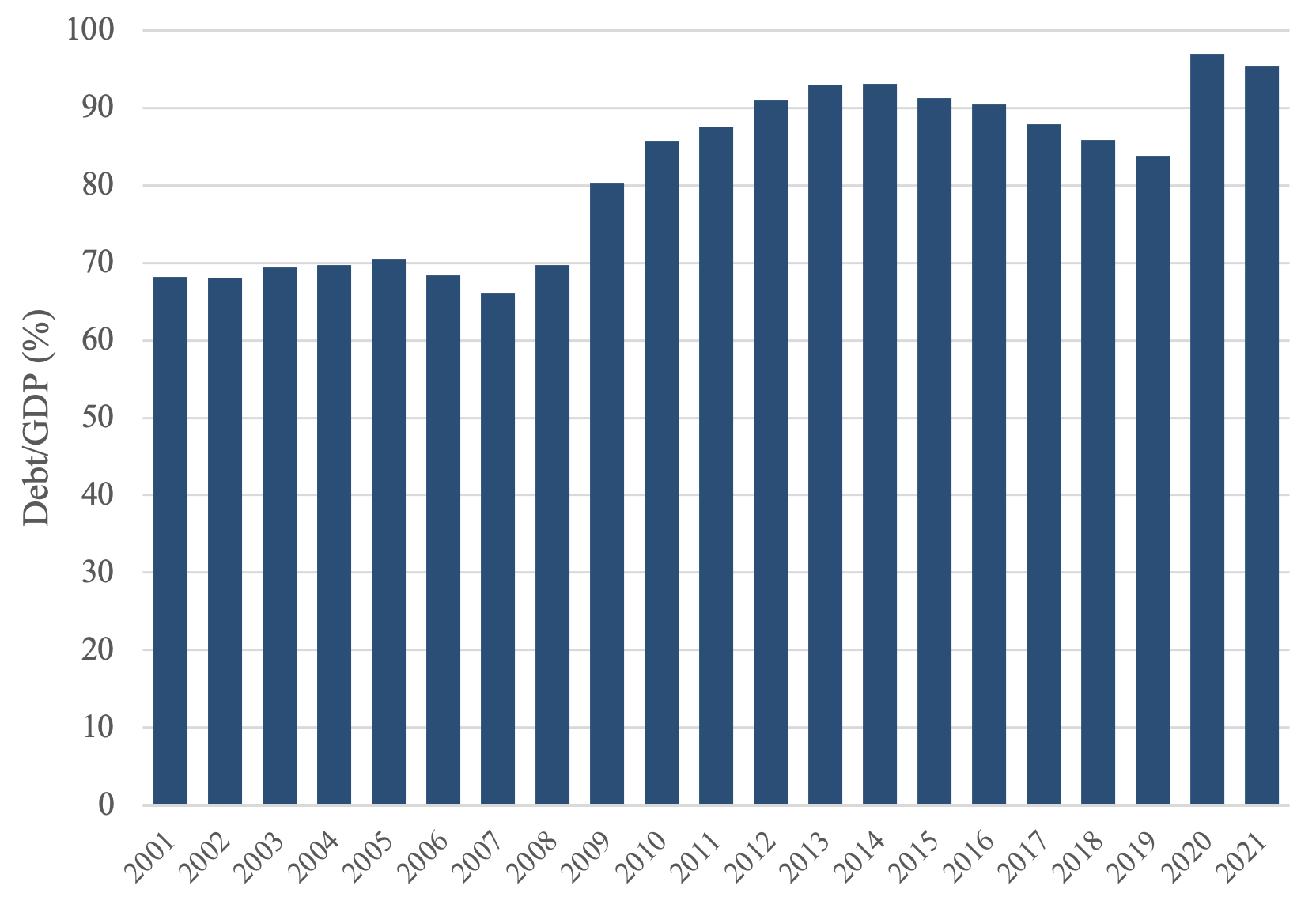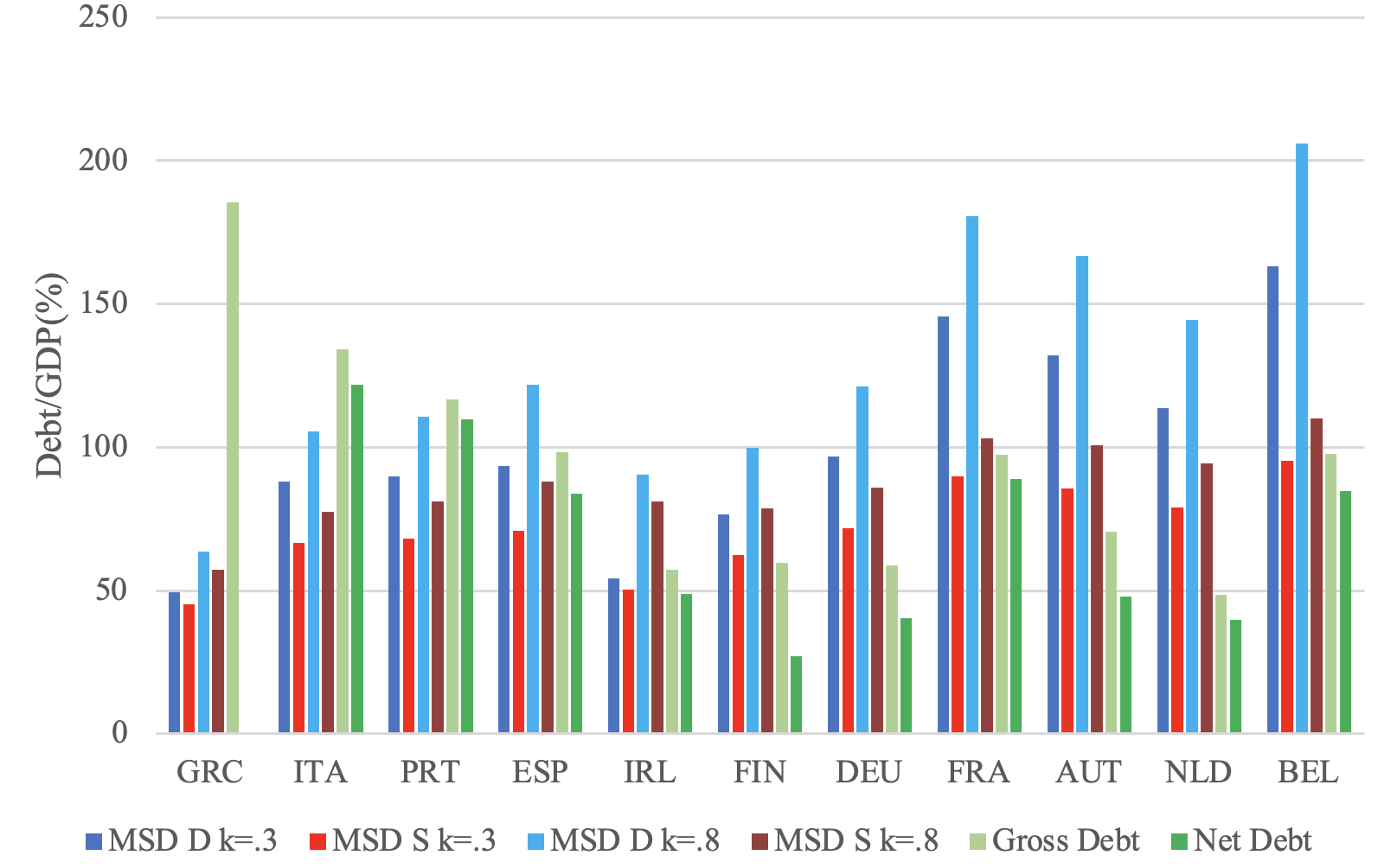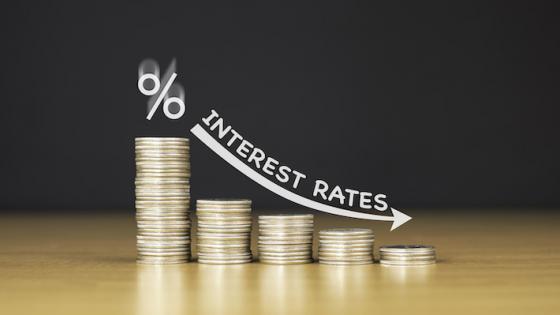The global financial crisis and the COVID-19 pandemic led to a rapid accumulation of public debt in both developing and advanced economies. In the euro area, debt increased by nearly 30 points of GDP over the period 2007-2021 (Figure 1).
Figure 1 Public debt in the euro area
Source: IMF WEO database
In the aftermath of the European debt crisis of 2011-2012, the ECB played an important role in stabilising the market for European sovereign debt. With inflation well below target, the ECB did not face any obvious tradeoffs in this stabilisation role. However, things have changed rapidly. Euro area inflation peaked at 10.5% in October 2022 and remains four times above target.
If expectations remain anchored, this can be good news for debt sustainability because a short-lived burst of inflation that leads to negative real interest rates can help to reduce debt-to-GDP ratios (Reinhart and Kirkegaard 2012, Reinhart and Sbrancia 2015). As pointed out by Blanchard’s influential presidential address, as long as the interest rate on the public debt, r, is lower than GDP growth, g, countries can stabilise (or reduce) their debt ratios even in the presence of moderate primary deficits. There are, however, two issues with this argument. First, r < g does not seem to hold in most advanced economies (Wyplosz 2019). Second, the current inflationary environment could usher a new era marked by high real interest rates.
If inflation does not converge rapidly to target, central banks will need to keep tightening in order to maintain credibility and keep expectations well-anchored (Corsetti and Codogno 2022). In the presence of high debt levels, higher rates can lead to another debt crisis within the euro area (Lorenzoni et al. 2022). Given this high level of uncertainty, the need to develop analytical tools aimed at evaluating debt sustainability and assessing the role of different policies aimed at preventing destructive debt crises is more important than ever.
We contribute to the literature with a model that derives a simple formula for a country’s maximum sustainable debt under the assumption that countries always try to repay their debts but might be pushed into default because they lack the resources necessary to service existing debt (Collard et al. 2022).
In our formula, the six main determinants of maximum sustainable debt are: expected growth, growth volatility, maximum primary surplus, the risk-free interest rate and its volatility, and the recovery rate in the immediate aftermath of default.
Our model encompasses and clarifies Blanchard’s result that, as long as r < g, countries can permanently run small deficits. We show that this result holds if there is no cost of default. Allowing for events that disrupt the process of debt rollover effectively amounts to a reduction in the growth rate, making debt sustainability harder to achieve. Using recent data, we find that the standard Blanchard condition is satisfied by the majority of countries in the euro area (the exceptions are Greece and Italy), but that no country satisfies our condition which explicitly allows for default.
In models rooted in the Eaton and Gersovitz (1981) tradition, a higher cost of default increases willingness to pay and leads to a higher debt limit. In our model, willingness to pay is always there and a higher cost of default leads to lower maximum sustainable debt. The result that a higher cost of default increases maximum sustainable debt has important policy implications. Reforms of the international financial architecture aimed at reducing the costs of default have often been criticised on the grounds that they would be inefficient ex-ante because they reduce willingness to pay and thus limit countries’ ability to borrow (Dooley 2000). We show that in the presence of involuntary default (an assumption in line with the new consensus that countries tend to default too little and too late, IMF 2013), such reforms might be efficient both ex-post and ex-ante.
We use our approach to estimate maximum sustainable debt using both a deterministic (MSD D) and stochastic risk-free rate (MSD R) with 30% (k = 0.3) and 80% (k = 0.8) recovery ratios. We then compare these thresholds with actual debt levels. Given our choice of parameters, we find that there are several Eurozone countries that have debt levels which are well above our estimated maximum sustainable debt. Specifically, when we compare our estimates for maximum sustainable debt with actual debt levels in 2019, we find that actual debt levels are well above our thresholds in Greece and Italy. When we use a 30% recovery ratio, we also find debt levels which are close to the maximum sustainable debt threshold in Portugal, Spain and Ireland (Figure 2).
Our finding of maximum sustainable debt levels which are below actual debt levels could be explained by the fact that that the high debt levels that we observe are driven by the expectation of higher future GDP growth and lower growth volatility. The service flow value of government debt (Brunnermeier et al. 2020) could be another explanation.
Figure 2 Maximum sustainable debt and actual gross and net public debt in 2019
Source: Own calculations and IMF WEO database.
We also explore the role of policy interventions. Specifically, we consider the role of an international lender that provides loans at a subsidised rate (as we focus on the euro area, we call this institution ESM, in a global setting our analysis could be generalised to the IMF). We find that, that the presence of such a lender plays a useful role as it increases maximum sustainable debt. However, we also show that policy interventions need to be carefully calibrated. While the international lender can increase a country’s debt limit, there is no free lunch. Indeed, in our model, this is an expensive lunch, with the present value of the subsidy provided by the lender being larger than the increase in maximum sustainable debt brought about by the intervention.
We focus on advanced economies that have a fully credible and independent central bank that is unwilling to monetise the debt. Thus, in our model there is no money or inflation and the model could be immediately applied to an emerging market country that only borrows abroad or has a credible fixed exchange rate. Extending the model to an emerging market country that borrows in both foreign and domestic currency and that does not have a fully credible central bank would require modelling both debt composition (i.e. the choice between domestic and foreign currency debt) and the temptation to inflate away domestic currency debt. Such a model could yield new avenues for studying debt sustainability in emerging market countries and for jointly analysing external and domestic debt sustainability.
References
Blanchard, O (2019), “Public Debt and Low Interest Rates”, American Economic Review 109(4): 1197-1229.
Brunnermeier, M, S Merkel and Y Sannikov (2020), “Debt As Safe Asset: Mining the bubble”, Princeton University, mimeo.
Collard, F, M Habib, and J-C Rochet (2015), “Sovereign Debt Sustainability in Advanced Economies”, Journal of the European Economic Association 13(3): 381–420.
Collard, F, M Habib, U Panizza and J-C Rochet (2022), “Debt Sustainability with Involuntary Default”, CEPR Discussion Paper 17357.
Corsetti, G and L Codogno (2022), “Shifts in expectations may undermine debt sustainability”, VoxEU.org, 3 November.
Dooley, M (2000), “International Financial Architecture And Strategic Default: Can Financial Crises Be Less Painful?”, Carnegic-Rochester Conference Series on Public Policy 53(1): 361-377.
Eaton, J and M Gersovitz (1981), “Debt with Potential Repudiation: Theoretical and Empirical Analysis”, Review of Economic Studies 48(2): 289–309.
IMF (2013), “Sovereign Debt Restructuring - Recent Developments and Implications for the Fund’s Legal and Policy Framework”, International Monetary Fund.
Lorenzoni, G, F Giavazzi, V Guerrieri and L D'Amico (2022), “Future challenges to European sovereign debt markets”, VoxEU.org, 19 December.
Reinhart, C and J Kirkegaard (2012), “Financial repression: Then and now”, VoxEU.org, 26 March.
Reinhart C and B Sbrancia (2015), “The Liquidation of Government Debt”, Economic Policy 30(82): 291–333,
Wyplosz, C (2019), “Olivier in Wonderland”, VoxEU.org, 17 June.









